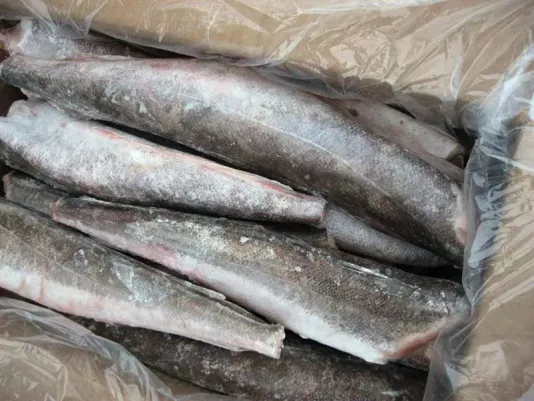Cabbage Rolls with Fish
Cabbage rolls with fish – Ukrainian cuisine recipe is very simple and delicious.

Hake is a versatile fish that I value for its tenderness and accessibility. Over the years of cooking, I’ve found that the quality of the result depends on freshness and thawing method. Good hake has light-colored meat without a strong smell of sea or metal, and the skin should be smooth, not slimy. It’s easy to cook even for those who rarely handle fish: the fillet holds its shape and doesn’t need long heat treatment. In my practice, hake performs well in a pan, oven, or steamer. I often use it as a base for dishes with vegetable sides or dairy-based sauces because it doesn’t overpower other ingredients. When I need to cook something healthy quickly, hake always saves the day. The main thing is not to overcook it: even a few extra minutes on high heat can take away its juiciness.
When I buy hake, I first look at the color and smell. Freshly frozen fish has matte skin without ice crusts, and if the pieces are covered with a thick layer of frost, it means refreezing. Such fillet becomes watery and loses flavor after cooking. I always check that the belly isn’t torn – this shows the fish was cleaned carefully. If choosing a whole fish, the eyes should be clear, not sunken. Stores often sell hake from different fishing regions – I’ve noticed that oceanic hake has slightly firmer meat than coastal ones. For frying, I choose larger fillets because they hold their shape better, while for baking in sauce, I prefer medium ones with a softer texture. It’s important to check the freezing date: old hake, even if processed correctly, will have a bitter aftertaste. I always choose vacuum-packed fish since it retains natural moisture better. If possible, I smell it: real hake smells like the sea, not ammonia.
Before cooking hake, I let it thaw naturally in the refrigerator. I don’t use hot water or a microwave – it ruins the protein structure. When the fillet has thawed, I pat it dry with a paper towel to remove excess moisture. If I need to remove the sea smell, I sprinkle it lightly with lemon juice or soak it for a few minutes in a milk-and-salt mixture. In my experience, this is the best way to keep it tender. For frying, it’s best to salt the fish slightly in advance – this prevents it from releasing too much juice during cooking. When I bake hake in the oven, I brush the surface with a thin layer of oil to prevent drying. There aren’t many bones in the fillet, but I always check by touch – sometimes there are thin needle-like ones that can be easily removed with tweezers. I add salt and spices moderately: too much salt destroys the meat’s delicacy. Proper preparation is half the success because even the best seasoning won’t save hake if it’s overcooked or poorly cleaned.
Hake responds well to medium heat. For the pan, I always heat the oil until a light smoke appears and place the fish skin side down – this prevents sticking. I cook it for a few minutes on each side over medium heat so a thin crust forms while the inside remains tender. When baking in the oven, 180-190°C (356-374°F) is the optimal range: higher temperatures make the protein coagulate too fast. For stewing or steaming, 10-15 minutes is enough – longer isn’t necessary. In my experience, when the fish starts to flake easily with a fork, that’s the sign it’s done. Too high a temperature makes hake dry, while too low makes it pale and bland. To retain juiciness, it’s worth adding a bit of butter at the end or covering it with a lid to let the steam distribute evenly. Avoid sudden temperature changes during cooking – they damage the structure and cause cracking.
Hake pairs well with light sides: boiled potatoes, rice, buckwheat, or stewed vegetables. I often serve it with carrots, onions, and celery – these vegetables add natural sweetness. For sauces, I use dairy bases: sour cream, yogurt, or cream with lemon juice – they highlight the delicate fish flavor. For a bolder taste, I add a bit of white wine or whole-grain mustard. The best spices are pepper, dill, parsley, thyme, and a touch of turmeric – but I never overdo it, to keep the natural taste. In my experience, even a simple lemon and a few drops of oil make the flavor harmonious. It’s best to avoid heavy tomato- or smoked-based sauces – they overpower the subtle aroma. I always emphasize that the right pairing shouldn’t be random. When the side dish complements rather than overshadows the hake, the dish turns out balanced, light, and nourishing.
The most common mistake is overcooking. Many people keep hake on the heat too long, afraid of raw meat, but this fish cooks faster than it seems. I always focus on texture: if the piece starts crumbling, it’s time to remove it. The second mistake is too many spices or too much breading. Hake has its own delicate aroma, and extra batter or strong seasonings overpower it. Another mistake is thawing in water – the fish loses up to a third of its juice. In my practice, I teach junior cooks: never rush, because the right temperature and calm preparation ensure quality. It’s also important to check the internal texture – cooked meat should be white and springy. A strong smell indicates spoiled product or improper storage. I always monitor dish cleanliness since even small traces of old oil can add bitterness. Control at every stage guarantees that hake will be tasty, tender, and safe.